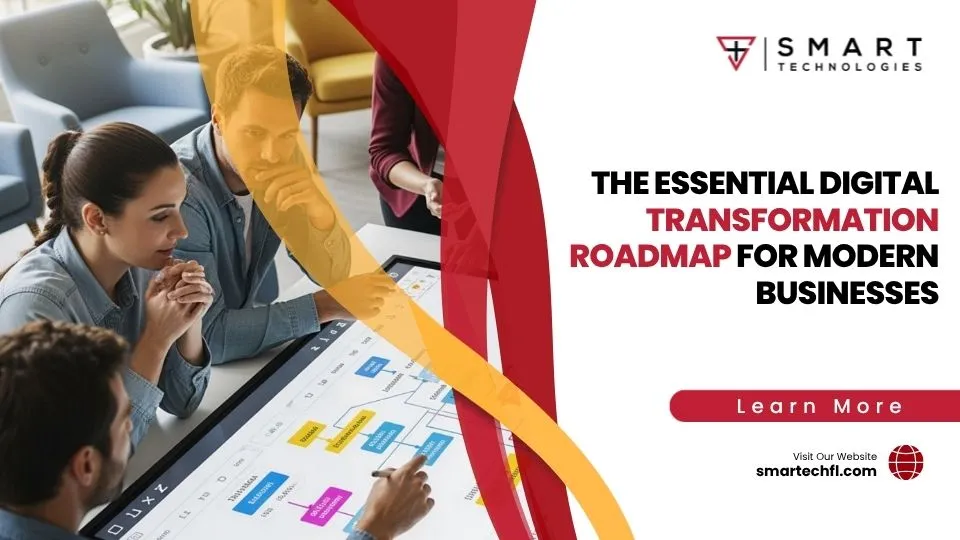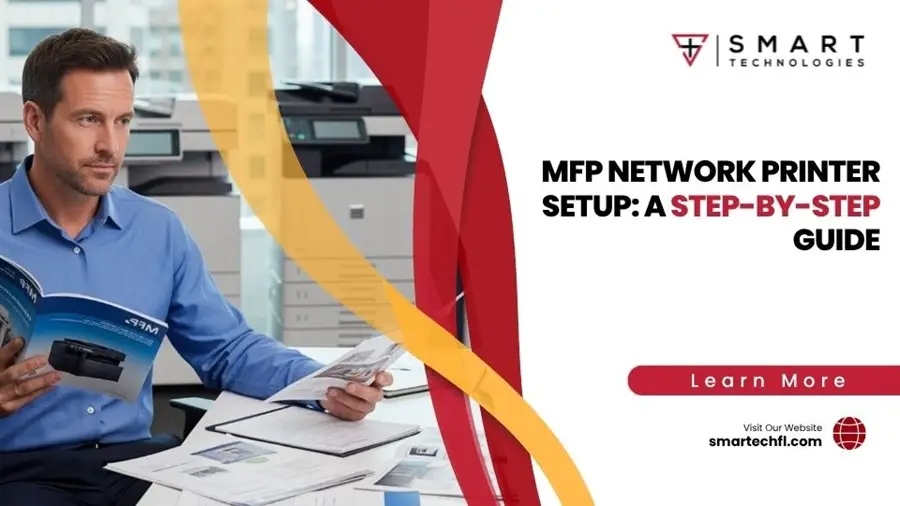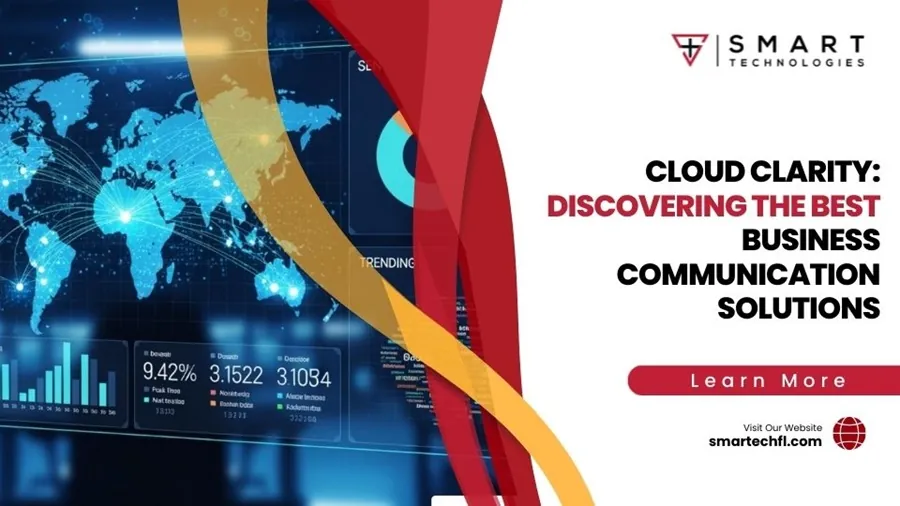IT Infrastructure Solutions Made Simple (Yes, Really!)
IT infrastructure solutions are the foundation of every successful modern business. They include all the hardware, software, networks, data centers, and services that support your business operations and digital services.
For businesses looking to understand IT infrastructure solutions, here’s a quick overview:
| Component | What It Includes | Why It Matters |
|---|---|---|
| Hardware | Servers, computers, mobile devices | Physical equipment that powers computing |
| Software | Operating systems, applications, security tools | Programs that run your business functions |
| Networks | Routers, switches, firewalls, internet connectivity | Connects systems and enables communication |
| Data Centers | Physical or virtual facilities for computing resources | Centralized locations for data processing |
| Cloud Services | IaaS, PaaS, SaaS solutions | Scalable, on-demand computing resources |
| Security | Firewalls, encryption, authentication systems | Protects data and ensures business continuity |
Businesses face a critical choice: continue with aging infrastructure that limits growth or accept modern solutions that drive efficiency, reduce costs, and enable innovation.
“Every company needs to successfully meet organizational workloads and accessibility,” notes industry experts. This is especially true as remote work becomes standard and customer expectations for digital experiences continue to rise.
Whether you’re considering cloud migration, hybrid solutions, or modernizing on-premises systems, the right IT infrastructure can reduce costs by 20-40% while significantly improving reliability and performance.
For retail businesses like yours, effective infrastructure directly impacts inventory management, point-of-sale systems, customer experience platforms, and your ability to compete in an increasingly digital marketplace.
The good news? You don’t need to be a technical expert to make smart infrastructure decisions. With the right guidance, these complex systems can be understood and leveraged to your advantage.
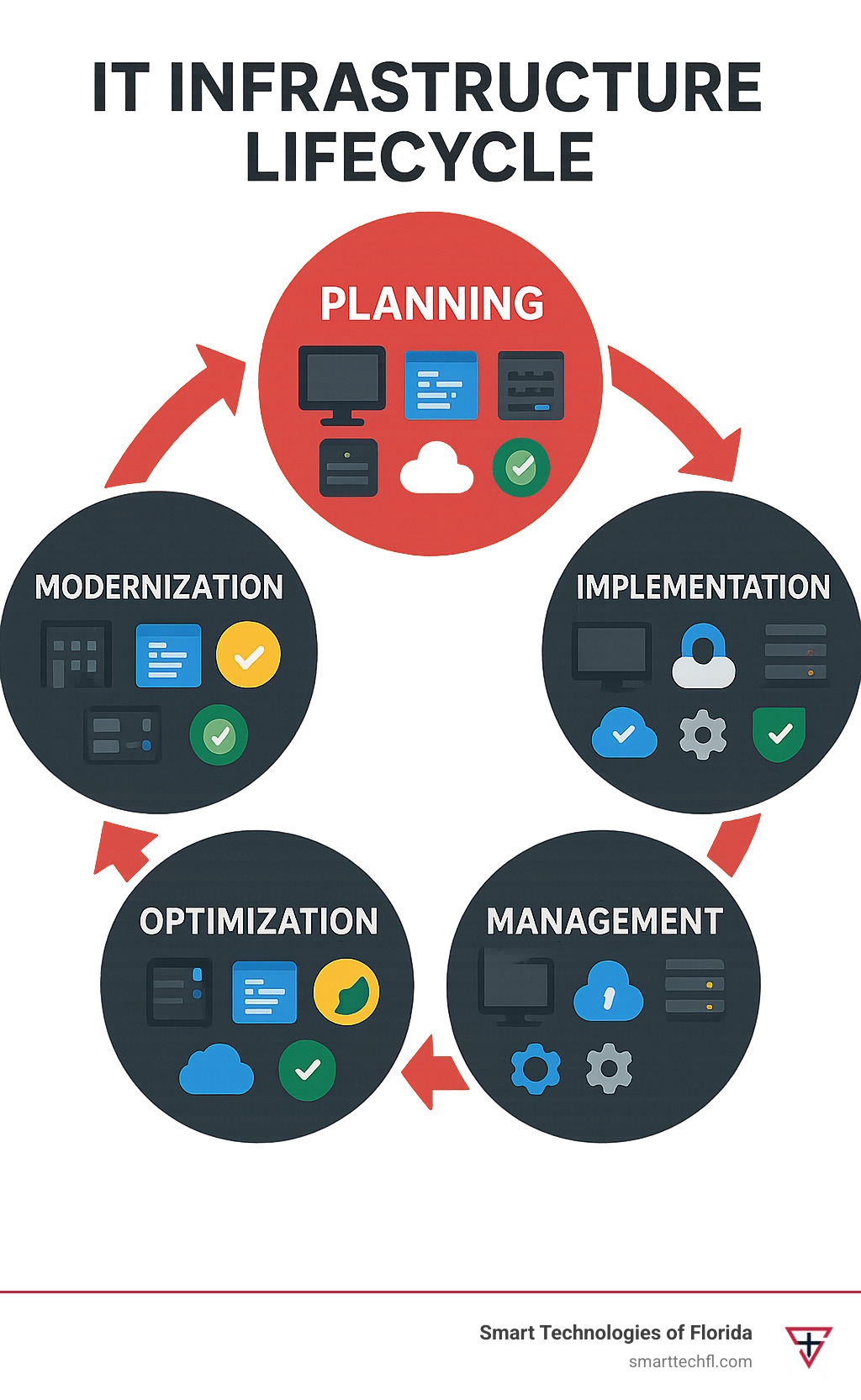
IT Infrastructure 101: Components & Importance
Think of IT infrastructure solutions as the skeleton and nervous system of your business. Without a strong, flexible backbone, even the most innovative business ideas will struggle to stand upright in today’s digital marketplace.
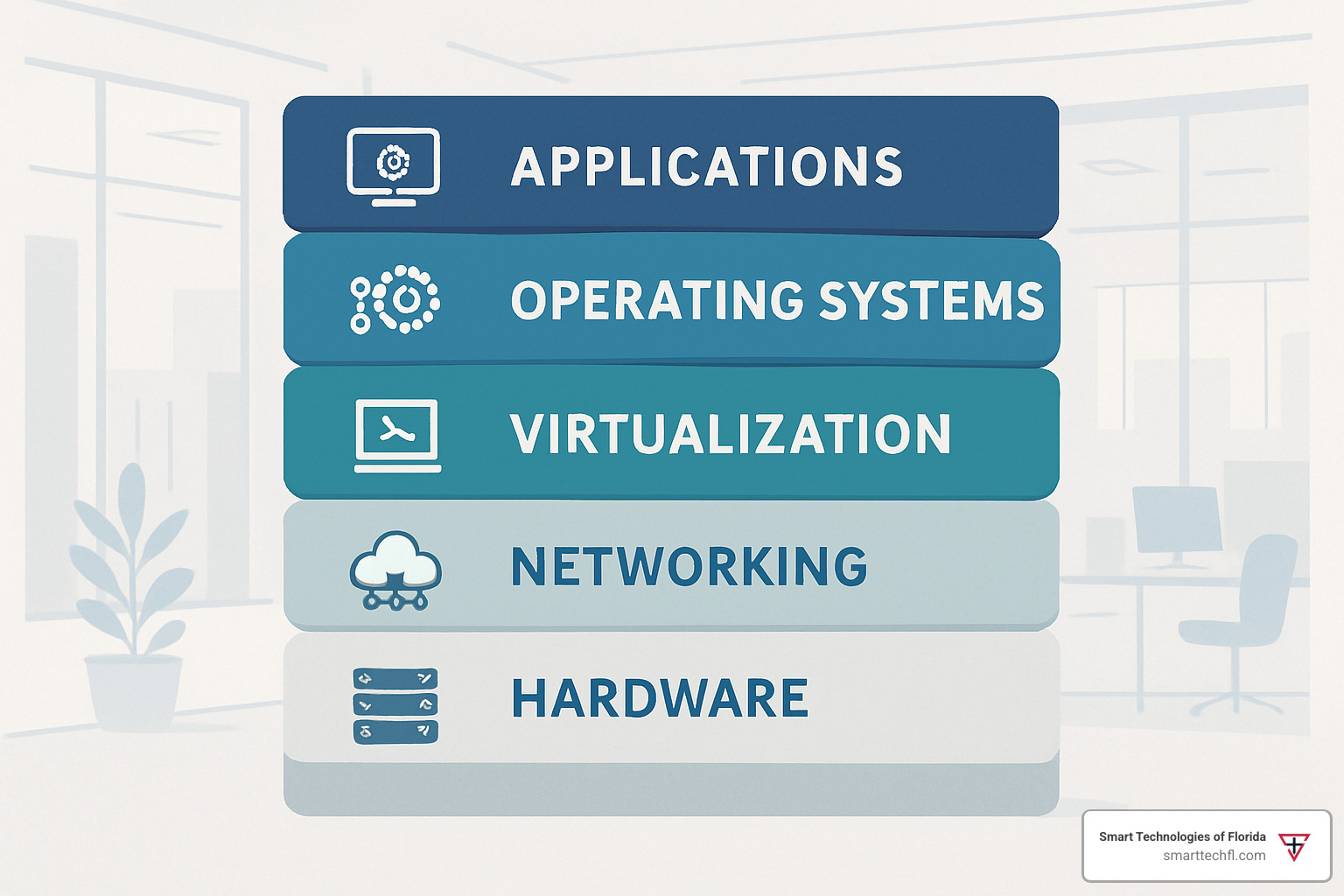
Modern IT infrastructure isn’t just about keeping the lights on—it’s a strategic asset that directly impacts your business success. When we sit down with clients at Smart Technologies of Florida, we often compare good infrastructure to good health: you don’t think about it when everything’s working well, but you certainly notice when something goes wrong!
Your infrastructure directly enables business agility—the ability to pivot quickly when market conditions change. It powers innovation by giving your team the tools to develop and launch new offerings. It builds resilience against disruptions (something we’ve all learned to value recently), and drives cost efficiency by optimizing your operational expenses.
In our 23 years helping Florida businesses transform, we’ve seen how the right infrastructure turns technology from a necessary expense into a competitive advantage.
Why Modern Businesses Rely on a Strong Backbone
The true value of robust IT infrastructure solutions becomes crystal clear when things go sideways:
When systems go down, the meter starts running—to the tune of $5,600 per minute according to Gartner research. That’s not a typo! Downtime is incredibly expensive, affecting everything from immediate sales to long-term customer trust.
Your team’s productivity takes a nosedive when they’re fighting with slow systems or hunting for inaccessible resources instead of doing their actual jobs. I remember one client whose employees were losing almost an hour daily to technology frustrations—that’s like paying for a 7-hour workday but only getting 6 hours of work!
And let’s talk about customer experience. When people expect Amazon-level responsiveness, slow-loading websites and glitchy apps don’t just annoy customers—they actively drive them to your competitors.
One of our retail clients in Daytona Beach learned this lesson the hard way when their aging systems buckled under holiday shopping traffic. The result? About $50,000 in lost sales during a critical 48-hour window. After implementing our recommended upgrades, they’ve maintained 99.99% uptime during peak seasons—turning what was once their most stressful time into their most profitable.
The Core Building Blocks
Let’s break down what actually makes up modern IT infrastructure solutions in terms everyone can understand:
Servers are your digital workhorses—processing data and running applications. Whether they’re physical machines humming away in your office or virtual servers living in the cloud, they’re handling the heavy lifting of your business operations.
Your storage solutions keep your valuable data accessible and secure. This might be traditional hard drives, sophisticated Storage Area Networks, or increasingly, cloud storage that scales with your needs.
Operating systems are the software foundation that manages your hardware and supports your applications—whether that’s Windows Server, Linux, or other specialized systems.
Your network equipment—routers, switches, access points—connects everything together. Think of these as the roads and highways allowing information to flow throughout your business and connect you to the outside world.
Security tools form your digital defense system. Firewalls, intrusion detection, antivirus software, and other protections safeguard your business assets from an increasingly sophisticated threat landscape.
Remote access solutions like VPNs and virtual desktops enable secure work from anywhere—something that’s evolved from “nice to have” to “absolutely essential” for most businesses.
What we’ve found at Smart Technologies of Florida is that many businesses focus too much on individual components without considering how everything works together. The magic happens not just in having great individual parts, but in how they’re integrated into a cohesive ecosystem where each element complements the others.
It’s like a well-rehearsed orchestra rather than a collection of talented soloists all playing different tunes. When everything harmonizes, your business doesn’t just function—it thrives.
IT Infrastructure Solutions: Traditional, Cloud, Hybrid & Edge
The landscape of IT infrastructure solutions has evolved dramatically in recent years, giving businesses more options than ever before. Each model has its strengths, and the right choice depends on your specific business needs, compliance requirements, and growth plans.
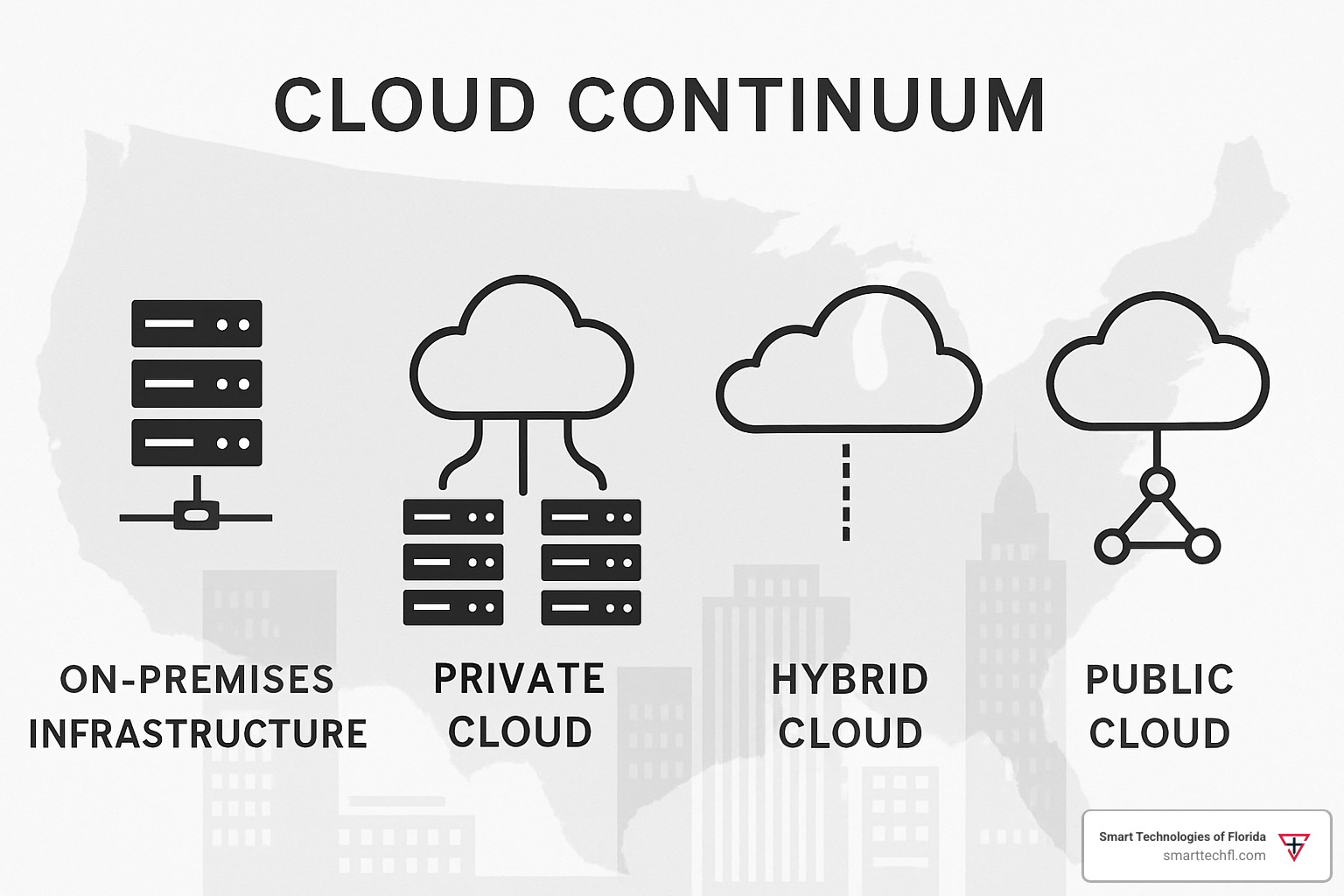
Traditional On-Premise IT Infrastructure Solutions
Remember when all your technology lived in that server room down the hall? Many businesses still find value in this approach. Traditional infrastructure—where you own and maintain physical equipment in your facilities—remains ideal for companies with specific compliance needs or specialized workloads.
What makes on-premise solutions attractive? Complete control over your hardware and software is a major benefit. You’ll also have direct physical access to your equipment whenever needed. This model typically follows a predictable capital expenditure approach to budgeting and often works better for certain compliance scenarios.
One of our manufacturing clients in Daytona Beach sticks with on-premises infrastructure for their production systems. For them, the control and reliability outweigh the higher upfront costs, especially when sub-millisecond response times can make or break their operations. The trade-off? You’ll need dedicated IT staff to keep everything running smoothly.
Cloud-Native IT Infrastructure Solutions
Cloud infrastructure has changed the game for businesses of all sizes. Instead of purchasing and maintaining physical equipment, you receive computing resources over the internet, allowing unprecedented flexibility.
The cloud brings remarkable elasticity to your business—scale resources up during busy seasons and down during quiet periods. You’ll appreciate the pay-as-you-go pricing that transforms large capital expenses into manageable operational costs. Need new resources quickly? Rapid deployment is another cloud advantage, along with built-in redundancy that protects your business continuity.
A local e-commerce client we support made the switch to cloud-native IT infrastructure solutions and watched their seasonal scaling headaches disappear overnight. Instead of paying year-round for servers sized to handle holiday traffic, they now automatically adjust resources based on actual demand—paying only for what they use.
According to research we’ve gathered, 82% of companies successfully achieving their cloud goals use managed services to a moderate or significant degree. This highlights something we’ve observed firsthand—expert guidance makes all the difference in cloud success. Expert research on infrastructure models confirms this trend across industries.
Hybrid & Multi-Cloud Approaches
Why choose between on-premises and cloud when you can have both? Hybrid infrastructure combines local and cloud resources, while multi-cloud strategies leverage services from multiple providers for maximum flexibility.
Smart businesses choose these blended approaches for several compelling reasons. Workload-appropriate placement lets you keep sensitive data on-premises while moving variable workloads to the cloud. You’ll avoid vendor lock-in while optimizing costs across different providers. These approaches also help you maintain legacy systems while adopting cloud technologies where they make the most sense.
As one of our financial services clients put it: “When we find a problem, we typically find a solution within Azure and change our approach as we go along.” Their hybrid approach maintains legacy databases on-premises while customer-facing applications thrive in the cloud—truly the best of both worlds.
Edge & Distributed Infrastructure
Edge computing brings processing power closer to where data is generated—right at the “edge” of your network. This approach is changing industries that need real-time processing and can’t afford delays.
The benefits are substantial: dramatically reduced latency for time-sensitive applications, decreased bandwidth costs by processing data locally, and improved privacy by keeping sensitive information closer to its source. Edge computing also offers improved reliability when internet connectivity is inconsistent—perfect for retail locations or remote facilities.
According to our research, a striking 83% of companies believe edge computing will be essential to remaining competitive in the future. We’re already seeing this play out with clients like a local retailer who implemented edge computing at their stores to process video analytics locally. This improved their inventory management and reduced shrinkage without overwhelming their network with constant video uploads.
Whether you’re considering traditional infrastructure, exploring cloud options, or looking at cutting-edge distributed systems, we at Smart Technologies of Florida can help you steer these choices with confidence. After 23 years of guiding businesses through technology changes, we’ve learned that the best infrastructure isn’t about following trends—it’s about finding the perfect fit for your unique business needs.
Modernization Journey: Benefits, Challenges & Case Studies
Modernizing your IT infrastructure isn’t just about shiny new tech—it’s about fundamentally changing how your business operates in today’s digital world. Think of it as renovating an older home: there’s excitement about the improvements, some disruption during the process, and ultimately, a more functional and efficient space when it’s complete.
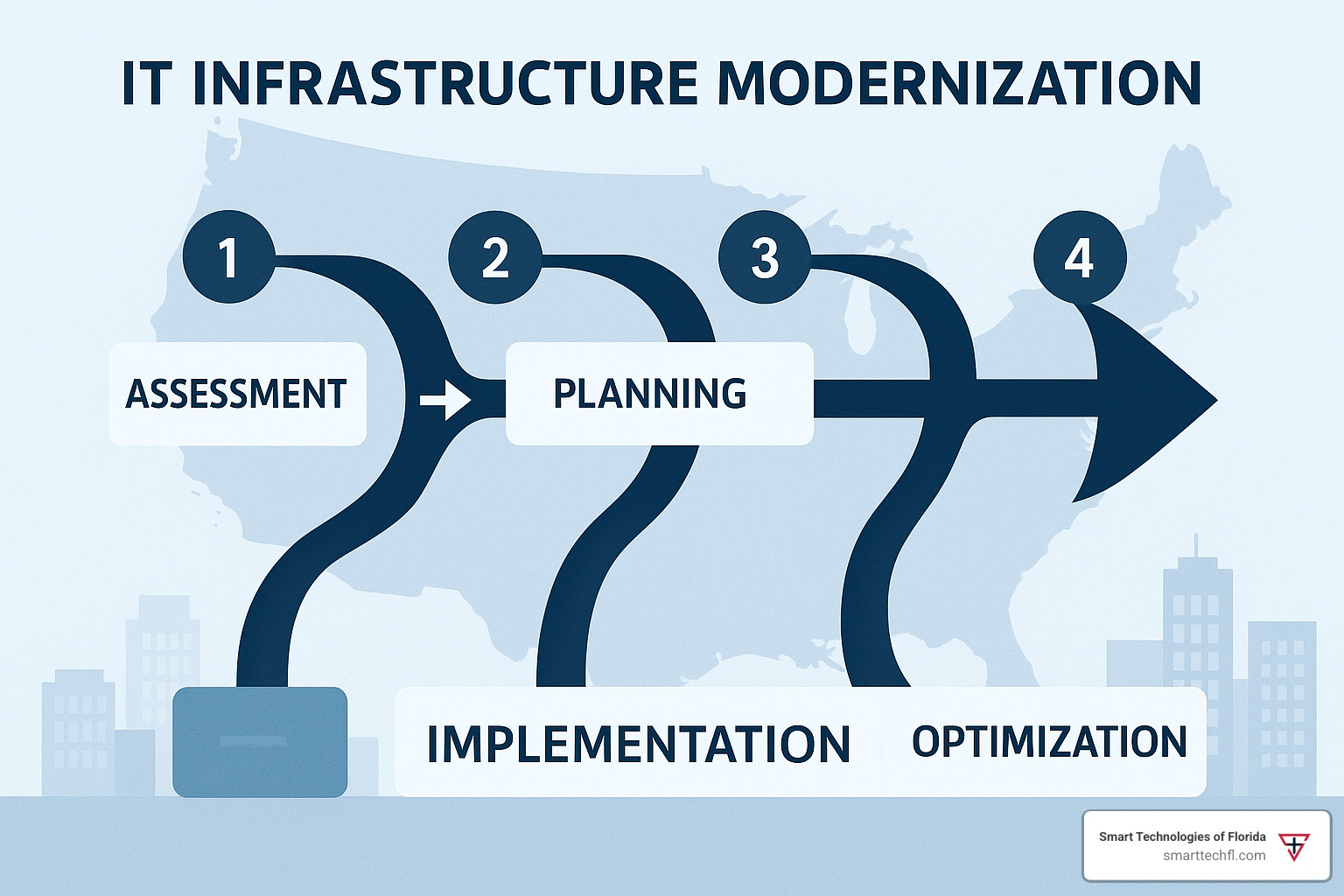
Key Benefits of Upgrading
When businesses take the leap to modernize their IT infrastructure solutions, the rewards can be truly game-changing.
I’ve seen how one of our manufacturing clients went from struggling with weekly system outages to becoming an industry leader in digital innovation. After modernizing, they reduced their product deployment timeline from several weeks to just hours—giving them a competitive edge they never thought possible.
Business agility becomes your new superpower with modern infrastructure. You can pivot quickly when market conditions change (something we’ve all learned is essential in recent years).
Innovation accelerates dramatically when your team isn’t bogged down maintaining legacy systems. One of our software development clients told me, “We used to spend 70% of our time keeping the lights on. Now it’s flipped—70% goes to creating new features our customers love.” After adopting containerized infrastructure, they tripled their release frequency.
The user experience improvements can be dramatic too. A local healthcare provider we work with saw patient satisfaction scores jump by 22% after implementing infrastructure that properly supported their new patient portal. As their CIO put it, “Patients used to complain about our technology. Now they rave about how easy everything is.”
There’s also a green benefit many don’t consider. Modern infrastructure typically runs much more efficiently, reducing your carbon footprint. One client slashed their data center power consumption by 40% through virtualization and cloud migration—something their sustainability team was thrilled to report to stakeholders.
Finally, let’s talk dollars and cents. AT&T’s experience is particularly telling—they reduced IT costs by approximately 30% by moving workloads to Azure, while achieving a remarkable 70% reduction in onsite requirements. That’s real money back into the business. Read the telecom cost-reduction story
Common Challenges & How to Overcome Them
Of course, the modernization path isn’t without its bumps. Here’s what we typically see when helping clients through this journey:
Technical debt is like financial debt—the longer you ignore it, the worse it gets. Years of quick fixes and outdated systems create a tangled web that can make migration complex. We always start with a thorough infrastructure assessment to map out dependencies and create a prioritized roadmap. This prevents the “where do we even start?” paralysis that stops many modernization efforts before they begin.
The skills gap is real—and you’re not alone if you’re feeling it. About 51% of executives we’ve spoken with cite lack of expertise as their biggest modernization barrier. This is where partnerships become invaluable. When we worked with a local accounting firm, we didn’t just implement new technology; we paired our specialists with their team for knowledge transfer, creating internal champions who could maintain momentum.
Change management often gets overlooked, but user resistance can derail even the most technically perfect implementation. A government agency client learned this the hard way when their first modernization attempt failed due to staff pushback. Their second attempt included comprehensive training and regular town halls to address concerns—and succeeded brilliantly.
Security concerns naturally arise during modernization. One healthcare client was particularly worried about patient data during their cloud migration. We implemented a zero-trust architecture with continuous monitoring that actually improved their security posture compared to their old perimeter-based approach.
Budget constraints affect nearly everyone—56% of executives report that maintaining legacy systems eats up resources needed for modernization. This is where phased approaches shine. We helped a retail client shift gradually from capital-heavy on-premises systems to an operational expense model in the cloud, spreading costs while delivering incremental benefits.
Success Stories in Action
The real magic happens when we see these modernization efforts pay off for real businesses:
A major telecommunications company acceptd the cloud and saw dramatic improvements across their operations. Their 30% reduction in overall IT costs freed up millions for innovation, while their 70% reduction in onsite infrastructure requirements meant they could repurpose valuable real estate. Most importantly, they significantly improved service delivery times, making both customers and internal teams happier.
Crocs (yes, the colorful shoe company) provides another compelling example. By leveraging Microsoft cloud infrastructure, they saved $250,000 annually while gaining the ability to scale rapidly during seasonal peaks. Their global teams now collaborate seamlessly, and IT resources previously tied up in maintenance now focus on enhancing customer experiences.
Closer to home, we worked with a regional bank to implement a hybrid solution that maintained strict compliance for sensitive customer data while modernizing their operations. Their disaster recovery testing went from a multi-day ordeal to a matter of hours, and they’ve been able to roll out new digital banking features at a pace that keeps them competitive with national chains.
As one CIO memorably told me after completing their modernization journey, “We thought we were just fixing our tech problems. What we actually did was transform our entire business.”
Architecting a Secure, Scalable & Cost-Efficient Infrastructure
Creating an IT infrastructure that perfectly balances security, performance, and cost-effectiveness isn’t just about technology—it’s about supporting your business goals. At Smart Technologies of Florida, we’ve spent over two decades developing a people-centric approach that ensures the technical solutions we implement truly serve your organization’s unique needs.
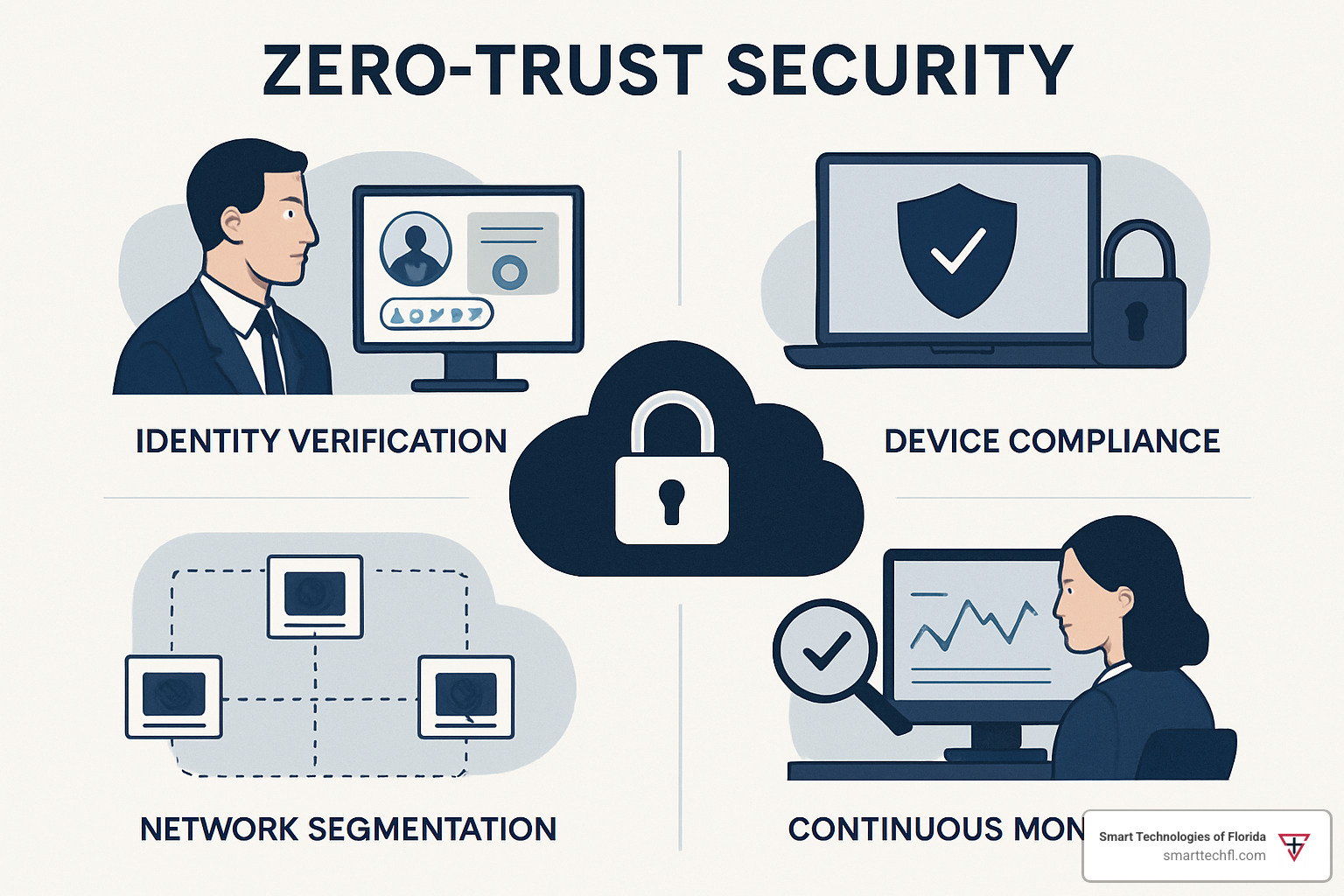
Security First: Best Practices
In today’s threat landscape, bolting security on as an afterthought is like installing a screen door on a submarine—technically possible but missing the point entirely. Security must be woven into every aspect of your IT infrastructure solutions from day one.
Think of security as layers of an onion. The outer layer might be your perimeter defenses like firewalls and intrusion prevention systems. Dig deeper and you’ll find network segmentation keeping potential threats contained. At the core, you’re protecting your data with encryption and controlling who can access it through robust identity management.
Patch management might not be glamorous, but it’s the digital equivalent of fixing a leaky roof before the rainy season. We’ve seen too many businesses compromised simply because they delayed critical updates. One manufacturing client reduced their security incidents by 70% just by implementing automated patch management—sometimes the simple fixes yield the biggest results.
Encryption everywhere isn’t just a catchy phrase—it’s a necessity. Whether your data is traveling across networks or sitting quietly in storage, it should be encrypted. One healthcare client we work with in Orlando implemented a zero-trust security model with comprehensive encryption as part of their infrastructure modernization. The result? A 60% reduction in security incidents and significantly improved HIPAA compliance.
Regular security audits are your reality check. As we like to tell our clients, you can’t protect what you don’t measure. Vulnerability assessments, penetration testing, and access control reviews should be as routine as changing the batteries in your smoke detectors. For more guidance on this critical process, check out our Network Security Audit Guide.
Performance & Scalability Tactics
A high-performing infrastructure should be like a good butler—always there when you need it, invisible when you don’t, and never complaining about the workload.
Auto-scaling capabilities ensure your systems flex with demand. Remember the old days when you’d have to provision for peak loads and then watch expensive servers sit idle most of the time? Those days are thankfully behind us. Now your resources can automatically adjust based on CPU utilization, memory usage, or customer traffic patterns.
One retail client in Daytona Beach implemented auto-scaling before their annual sale event. While their competitors’ websites slowed to a crawl under heavy traffic, our client’s site hummed along smoothly despite a 500% traffic increase. The cherry on top? They actually reduced their infrastructure costs by 15% through more efficient resource utilization.
Load balancing is like having a skilled traffic cop at a busy intersection. It directs digital traffic efficiently, preventing any single resource from becoming overwhelmed while others sit idle. This not only improves performance but also improves reliability—if one server fails, traffic automatically routes to healthy servers.
Monitoring is your early warning system. By tracking both system metrics and actual user experience, you can spot problems before they affect your customers. As one client put it, “Before we implemented proper monitoring, we were always the last to know when something went wrong—usually when an angry customer called.”
Rightsizing your resources is both an art and a science. Too many resources waste money; too few frustrate users. By analyzing actual usage patterns, you can find that sweet spot where performance and cost efficiency meet.
Cost Optimization & Governance
Cloud bills that mysteriously balloon each month aren’t inevitable—they’re a symptom of poor governance. With proper oversight, your IT infrastructure solutions can deliver maximum value at minimum cost.
Reserved capacity options offer significant discounts when you commit to longer-term usage. Think of it like buying in bulk—you get a better rate in exchange for a longer commitment. For predictable workloads, this can reduce costs by 40-60% compared to on-demand pricing.
For less critical workloads, spot instances let you take advantage of unused capacity at steep discounts. It’s like flying standby—you save money but need to be flexible. We helped one client reduce their development and testing costs by 70% using spot instances with automated workload scheduling.
Tracking the right metrics makes all the difference. Rather than focusing solely on the raw cloud bill, we help clients establish meaningful KPIs like cost per transaction or resource utilization rates. This shifts the conversation from “How much are we spending?” to “What value are we getting?”
Bringing financial accountability to cloud spending—what the industry calls FinOps—is essential for sustainable growth. This means implementing tagging strategies so you know exactly which department or project is responsible for which costs, setting up budget alerts to catch unexpected spending spikes, and fostering a cost-conscious culture across teams.
The results speak for themselves. ScienceSoft reports making IT costs 20-40% lower through rightsizing and strategic use of reserved and spot instances—tactics we regularly implement for our clients. One manufacturing client reduced their cloud spending by 35% while actually increasing their use of advanced services.
Want to learn more about how we can help optimize your infrastructure? Check out our Managed IT Solutions and Comprehensive IT Services & Support pages for more details on our approach.
The Future & FAQs: Trends, Automation, and Your Next Move
The landscape of IT infrastructure solutions continues to evolve rapidly, with emerging technologies reshaping what’s possible. At Smart Technologies of Florida, we help businesses not just keep pace with these changes but leverage them for competitive advantage.

I love talking about the future of technology because it’s where possibility meets practicality. Right now, we’re seeing some fascinating developments that are changing how businesses approach their digital backbone.
AIOps is changing how we manage infrastructure – imagine having a digital assistant that spots potential server issues before they cause problems and fixes them automatically. For one of our manufacturing clients, this reduced their critical incidents by 75% in just six months.
The concept of self-healing infrastructure takes this even further. These systems can detect when something’s not right and repair themselves without human intervention – like having a car that changes its own flat tire while you keep driving. One client described it as “like having an IT team that never sleeps.”
Infrastructure as Code has been a game-changer for many of our clients. Instead of manually configuring servers (a tedious, error-prone process), we define everything through code. This means we can spin up identical environments in minutes rather than days, and changes are consistent every time.
With businesses increasingly using services from multiple cloud providers, multi-cloud orchestration tools help manage this complexity. It’s like having a universal remote for all your cloud services – simplifying management while optimizing where each workload runs.
The sustainability focus isn’t just good for the planet – it’s good for your bottom line too. Modern, energy-efficient infrastructure can significantly reduce power costs while helping meet corporate environmental goals. One client reduced their data center power consumption by 32% while actually increasing computing capacity.
Edge AI is particularly exciting for businesses that need real-time processing. By putting AI capabilities at the edge of networks (closer to where data is generated), decisions can be made instantly without sending data to centralized systems. For retail clients, this enables real-time inventory management and personalized customer experiences.
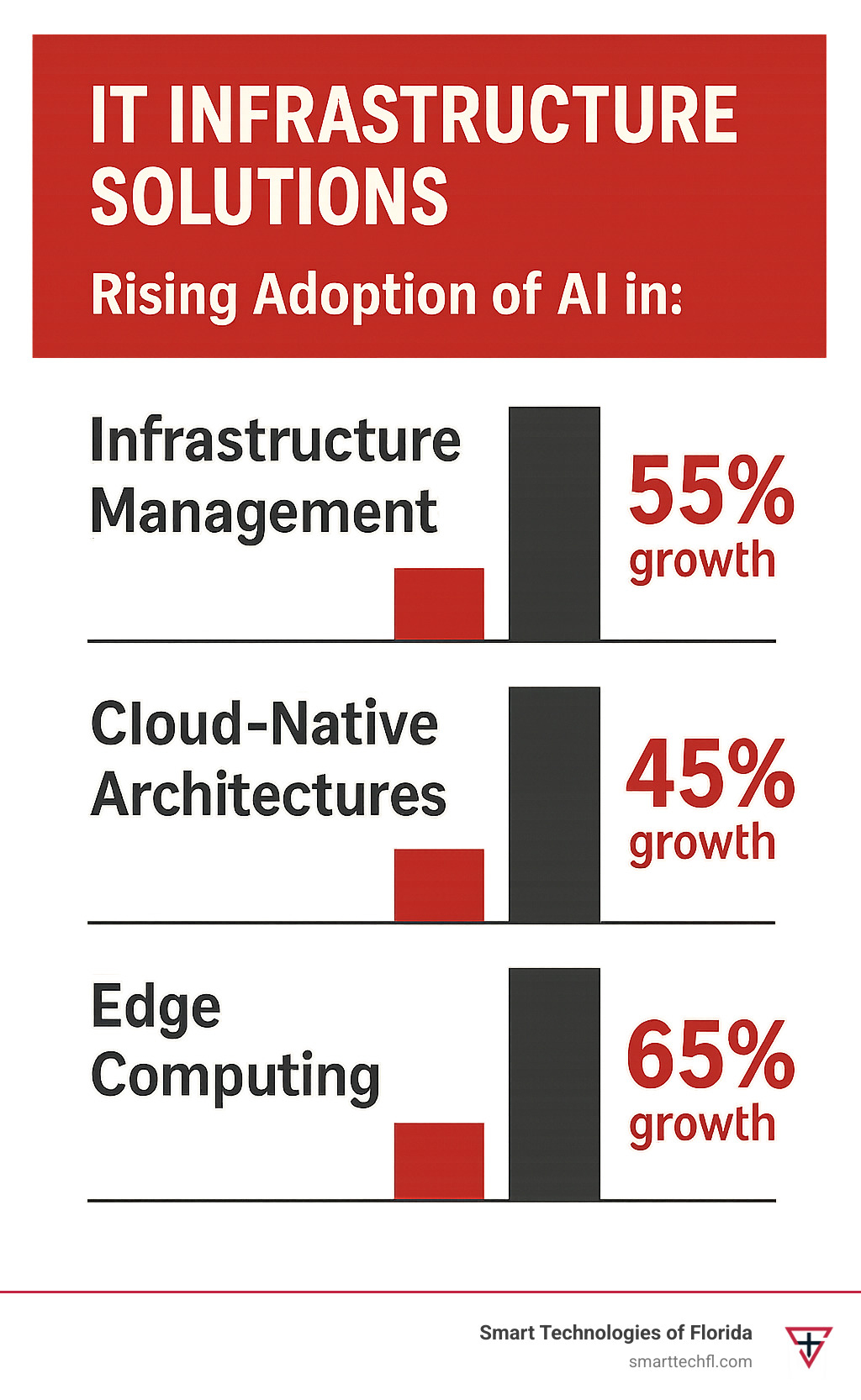
Frequently Asked Questions about IT Infrastructure Solutions
What is the difference between traditional and cloud IT infrastructure?
I’m often asked this question, and the simplest way to explain it is this: traditional infrastructure is like owning a car, while cloud infrastructure is like using Uber.
With traditional (on-premises) infrastructure, you buy the equipment, keep it in your building, and your team maintains it. You have complete control, but also complete responsibility. It’s predictable in terms of costs after the initial investment but requires significant upfront capital.
Cloud infrastructure, on the other hand, delivers computing resources over the internet as a service. You pay for what you use, can scale up or down quickly, and the provider handles the maintenance. It’s more flexible but can have variable monthly costs.
The trade-offs come down to several factors. Control versus management burden is a big one – do you want complete control if it means handling all maintenance yourself? Capital versus operational expenses is another important consideration – would you rather make a large upfront investment or pay monthly? Performance versus scalability also matters – on-premises systems might offer more consistent performance for certain workloads but can’t scale as quickly as cloud systems.
Security considerations often weigh heavily in this decision too. With traditional infrastructure, you have physical control over your systems but need to implement all security measures yourself. Cloud providers offer sophisticated security tools, but you still need to configure them properly.
How do I choose the right IT infrastructure solution for my business?
This is where having a trusted partner really helps. At Smart Technologies of Florida, we start by understanding your business first, then recommend technology – never the other way around.
Begin with a thorough business requirements analysis. What performance do you need? How much does your workload vary throughout the day or year? Do you have specific compliance requirements like HIPAA or PCI DSS? How geographically distributed is your organization? What’s your expected growth trajectory?
Then look at the total cost of ownership over 3-5 years. This includes hardware, software, maintenance, staffing, training, and facilities costs. Don’t forget to factor in opportunity costs – what could your team accomplish if they weren’t managing servers?
A proper risk assessment is equally important. What are the security implications of different approaches? What happens if systems go down? Could you become too dependent on a single vendor? How will today’s decisions affect your options in the future?
For many of our clients in Daytona Beach and throughout Florida, a hybrid approach offers the best balance – keeping sensitive operations on-premises while leveraging cloud resources for scalability and innovation.
How can I control costs while scaling my infrastructure?
Cost management is absolutely crucial, especially as you grow. Without proper oversight, infrastructure costs can quickly spiral out of control.
FinOps practices make a huge difference. This means establishing clear ownership of infrastructure costs (who’s responsible for what spending?), tagging resources so you know exactly what each department or project is costing, setting budgets with automated alerts when you approach limits, and scheduling regular optimization reviews.
Monitoring and analytics provide the visibility you need. You can’t optimize what you can’t measure! Track how resources are actually being used, identify idle or underused systems, forecast capacity needs based on trends, and set up automated scaling based on actual usage patterns.
Many businesses find that managed services offer significant cost advantages. Rather than building an in-house team with every specialized skill needed, you can access expertise as needed, benefit from economies of scale, and focus your internal resources on strategic initiatives that drive growth.
I remember one e-commerce client who was frustrated by ever-increasing infrastructure costs as their business grew. After implementing these practices with our guidance, they reduced their infrastructure spending by 28% while handling 40% more traffic. The savings went directly to their marketing budget, accelerating their growth even further.
Your Roadmap Forward & Final Thoughts
Changing your IT infrastructure is definitely a journey, not a one-time project. Here’s a practical roadmap to get started:
First, conduct an honest assessment of your current infrastructure against your business goals to identify gaps and opportunities. Then develop a strategy with a phased approach that balances immediate needs with long-term objectives – trying to change everything at once rarely works well.
Carefully consider partner selection – choose technology partners and service providers who take the time to understand your business context, not just sell you products. During implementation, pay special attention to change management and user training – the best technology fails if people don’t adopt it. Finally, commit to ongoing optimization – continuously monitor, measure, and refine your infrastructure as business needs evolve.
At Smart Technologies of Florida, we believe that technology should serve people, not the other way around. Our people-centric approach ensures that your IT infrastructure solutions align with your unique business goals and empower your team rather than creating new complexities.
With 23 years of experience serving businesses in Daytona Beach and beyond, we’ve seen how the right infrastructure can transform organizations—enabling innovation, improving customer experiences, and driving growth.
The complexity of modern IT can be daunting, but you don’t have to steer it alone. Whether you’re just beginning your modernization journey or looking to optimize existing systems, we’re here to help make IT infrastructure simple—yes, really!





